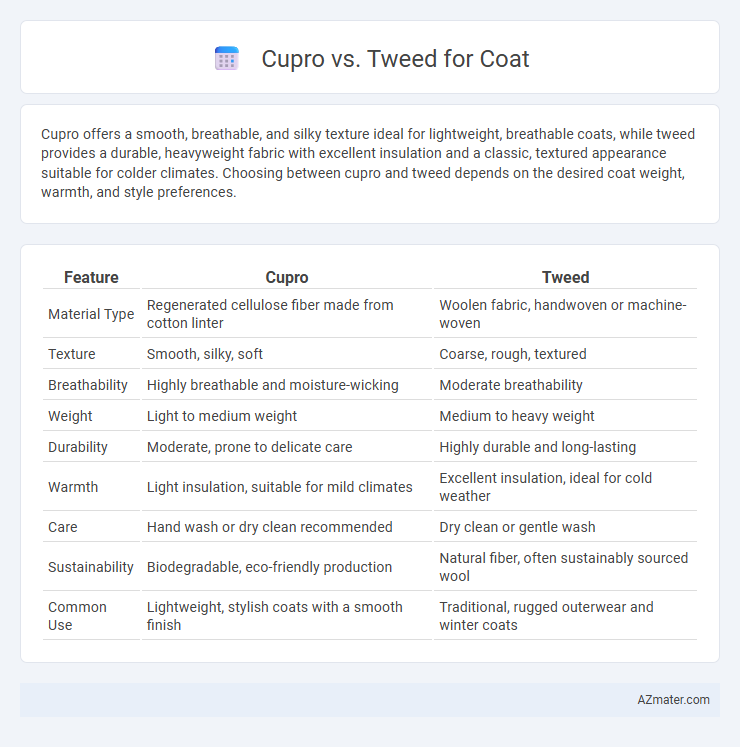Cupro offers a smooth, breathable, and silky texture ideal for lightweight, breathable coats, while tweed provides a durable, heavyweight fabric with excellent insulation and a classic, textured appearance suitable for colder climates. Choosing between cupro and tweed depends on the desired coat weight, warmth, and style preferences.
Table of Comparison
| Feature | Cupro | Tweed |
|---|---|---|
| Material Type | Regenerated cellulose fiber made from cotton linter | Woolen fabric, handwoven or machine-woven |
| Texture | Smooth, silky, soft | Coarse, rough, textured |
| Breathability | Highly breathable and moisture-wicking | Moderate breathability |
| Weight | Light to medium weight | Medium to heavy weight |
| Durability | Moderate, prone to delicate care | Highly durable and long-lasting |
| Warmth | Light insulation, suitable for mild climates | Excellent insulation, ideal for cold weather |
| Care | Hand wash or dry clean recommended | Dry clean or gentle wash |
| Sustainability | Biodegradable, eco-friendly production | Natural fiber, often sustainably sourced wool |
| Common Use | Lightweight, stylish coats with a smooth finish | Traditional, rugged outerwear and winter coats |
Introduction to Cupro and Tweed Fabrics
Cupro is a regenerated cellulose fiber made from cotton linter, known for its silky texture, moisture-wicking properties, and breathability, making it an excellent choice for lightweight linings and soft, drapey garments. Tweed, traditionally woven from wool, features a rough texture and distinctive patterns like herringbone or checks, prized for its warmth, durability, and classic aesthetic in outerwear such as coats. Both fabrics serve distinct functions in coat construction: cupro offers comfort and smoothness as a lining material, while tweed provides sturdy, weather-resistant structure for the coat's exterior.
Origins and History of Cupro and Tweed
Cupro, a regenerated cellulose fiber derived from cotton linter, originated in the early 20th century as an innovative alternative to silk, prized for its smooth texture and breathability. Tweed, woven from coarse wool and rooted in Scotland and Ireland, has centuries-old origins as a durable fabric designed for outdoor wear, famously associated with traditional British country attire. Both materials reflect distinct cultural histories and functional purposes in coat-making, with Cupro embodying modern sustainability and Tweed representing rugged heritage.
Composition: What Is Cupro? What Is Tweed?
Cupro is a regenerated cellulose fiber made from cotton linter, known for its silk-like texture and breathability, often blended with other fibers for enhanced durability in coats. Tweed is a rough, woolen fabric characterized by its dense weave and moisture resistance, traditionally made from pure sheep's wool, providing warmth and durability in outerwear. The composition differences make cupro ideal for lightweight, smooth linings, while tweed excels as a sturdy, insulating outer fabric for coats.
Texture and Appearance Comparison
Cupro offers a smooth, silky texture with a lustrous sheen that enhances the coat's refined and modern appearance, making it ideal for sleek, polished outerwear. Tweed, on the other hand, features a coarse, nubby texture with intricate, woven patterns, providing a classic, rugged look characterized by its rich depth and earthy tones. Both materials deliver distinct tactile and visual qualities, where Cupro emphasizes elegance and softness, while Tweed highlights durability and traditional charm.
Warmth and Insulation Properties
Cupro offers moderate warmth and breathability due to its semi-synthetic fiber structure, making it less insulating in extremely cold conditions. Tweed, crafted from dense wool, provides superior insulation and excellent heat retention, ideal for colder climates. The natural lanolin content in tweed enhances its moisture-wicking abilities, further improving warmth and comfort.
Durability and Longevity
Cupro, a regenerated cellulose fiber derived from cotton linter, offers a smooth texture but tends to be less durable and prone to wear over time when used in coats. Tweed, traditionally made from tightly woven wool, is highly valued for its exceptional durability, resistance to abrasion, and ability to maintain structure and warmth across seasons. For longevity in coat fabrics, tweed consistently outperforms cupro due to its robust natural fibers and time-tested resilience.
Sustainability and Environmental Impact
Cupro, a regenerated cellulose fiber made from cotton linter, offers a sustainable alternative with biodegradability and a lower environmental footprint compared to synthetic fabrics. Tweed, traditionally made from wool, benefits from natural renewable sourcing but involves intensive water and energy use in weaving and dyeing processes. Choosing Cupro over Tweed for coats can reduce reliance on animal agriculture and promote circular fashion through its recyclability and eco-friendly production techniques.
Style and Versatility for Coat Designs
Cupro offers a smooth, silky texture that drapes elegantly, making it ideal for tailored coat designs with a sophisticated, modern aesthetic. Tweed features a textured, rugged surface that provides warmth and a classic, timeless style perfect for structured, vintage-inspired coats. Both fabrics enhance versatility, with cupro suited for sleek, lightweight outerwear and tweed excelling in durable, weather-resistant coat options.
Care and Maintenance Requirements
Cupro coats require delicate care due to their semi-synthetic fibers that are prone to shrinkage and damage from high heat; dry cleaning is recommended to maintain fabric integrity and sheen. Tweed coats, made from durable wool fibers, are more resilient and often require less frequent cleaning, with spot cleaning and occasional professional dry cleaning maintaining their texture and shape. Proper storage for both fabrics, like using breathable garment bags and avoiding compression, prolongs coat longevity and preserves material quality.
Which Is Better for Coats: Cupro or Tweed?
Cupro offers a smooth, breathable, and silky texture ideal for lightweight, luxurious coat linings, enhancing comfort and drape. Tweed, made from sturdy wool, provides warmth, durability, and a classic textured appearance suitable for outercoats in colder climates. Choosing between cupro and tweed depends on the coat's purpose: cupro excels in lining quality, while tweed delivers superior insulation and rugged style as the outer fabric.

Infographic: Cupro vs Tweed for Coat
 azmater.com
azmater.com